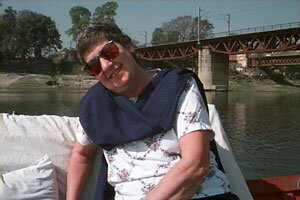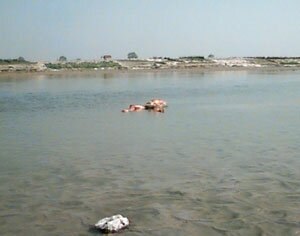|
01-Mar-2004

Eco Friends takes Dr. Elizabeth A. Guillette for a boat ride on the Ganga. Here is her account of the experience.
 Lectures on the impacts of pollution on human health to about two thousand students from various schools, and hearing their perceptions of the environment, did little to prepare me for today’s boat ride down the Ganga. The boat ride provided true insight into what is occurring to the river in Kanpur, and probably other river settlements in India. Once standing as a symbol for religion and health, the Ganga is destroyed and devoid of beauty. The beauty is replaced with trash, plastic bags, wads of human waste and city waste. I only wish the camera could record the stench that went with the sights -breath-holding instead of breath-taking. On the Kanpur side of the river, the direct discharge of untreated human and industrial waste is evident to the eyes and nose. At the site of the tanneries there was a tumbling waterfall of chemical discharge. The surrounding earth was stained a vivid blue, with a darker blue hue extending into the water. The stench now became that of a nauseating, lung irritating odor. Lectures on the impacts of pollution on human health to about two thousand students from various schools, and hearing their perceptions of the environment, did little to prepare me for today’s boat ride down the Ganga. The boat ride provided true insight into what is occurring to the river in Kanpur, and probably other river settlements in India. Once standing as a symbol for religion and health, the Ganga is destroyed and devoid of beauty. The beauty is replaced with trash, plastic bags, wads of human waste and city waste. I only wish the camera could record the stench that went with the sights -breath-holding instead of breath-taking. On the Kanpur side of the river, the direct discharge of untreated human and industrial waste is evident to the eyes and nose. At the site of the tanneries there was a tumbling waterfall of chemical discharge. The surrounding earth was stained a vivid blue, with a darker blue hue extending into the water. The stench now became that of a nauseating, lung irritating odor.
 People appeared immune to the human impact on the water quality. Men, women and children were drinking the water, taking daily baths and cleaning their mouths amid the floating filth. Clothing was being washed. There is a public toilet in the river itself, with about 7 squatting people relieving themselves. Young boys were swimming and at play in the water. Dead bodies were floating past them. The royal send-off of the deceased has been replaced by an easy and cheap disposal method of the dead. Most of the 10 bodies we saw in the two-hour ride were wrapped in gauze. But one was a terrible sight – a woman, in traditional dress, stared into space, with arms and legs outstretched as she floated near a bridge. A group of boys, diving and swimming, were oblivious to her, as though she was just a log floating downstream. People appeared immune to the human impact on the water quality. Men, women and children were drinking the water, taking daily baths and cleaning their mouths amid the floating filth. Clothing was being washed. There is a public toilet in the river itself, with about 7 squatting people relieving themselves. Young boys were swimming and at play in the water. Dead bodies were floating past them. The royal send-off of the deceased has been replaced by an easy and cheap disposal method of the dead. Most of the 10 bodies we saw in the two-hour ride were wrapped in gauze. But one was a terrible sight – a woman, in traditional dress, stared into space, with arms and legs outstretched as she floated near a bridge. A group of boys, diving and swimming, were oblivious to her, as though she was just a log floating downstream.
 On a river island, there are small agricultural plots. The farmers walked along the banks containing the usual trash and plastic bags to dip their buckets in the river for irrigating the food plants. Nearby, fishermen proudly displayed up their catch, someone’s meal for the evening. I ask myself what are these people really eating and drinking. What assorted man-made industrial chemicals, pesticides, heavy metals, bacteria, viruses are they ingesting? One of the boatmen couldn’t answer my question, instead saying his wife had been pregnant four times, with only one child born alive. He was lucky, as other men and women were sterile. Others had stomach and digestive problems and infections of all types were common. On a river island, there are small agricultural plots. The farmers walked along the banks containing the usual trash and plastic bags to dip their buckets in the river for irrigating the food plants. Nearby, fishermen proudly displayed up their catch, someone’s meal for the evening. I ask myself what are these people really eating and drinking. What assorted man-made industrial chemicals, pesticides, heavy metals, bacteria, viruses are they ingesting? One of the boatmen couldn’t answer my question, instead saying his wife had been pregnant four times, with only one child born alive. He was lucky, as other men and women were sterile. Others had stomach and digestive problems and infections of all types were common.
How lucky some of us are to have clean water. Safe water should be available to everyone. My thanks to Eco Friends for their Clean the Ganga project.
Elizabeth
(Dr. Elizabeth A Guillette from University of Florida, USA
is visiting Eco Friends from Feb 22 to Mar 7, 2004.
She specializes in contaminants like pesticides and
its health impacts. )
Related Links:
Report (23-Feb-04 ): Contaminants and human health
(22-Feb-04): Dr. Elizabeth A Guillette from University of Florida, USA is visiting Eco Friends.
|
